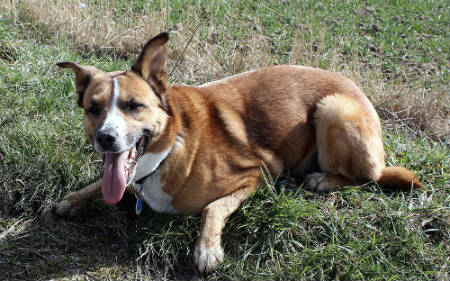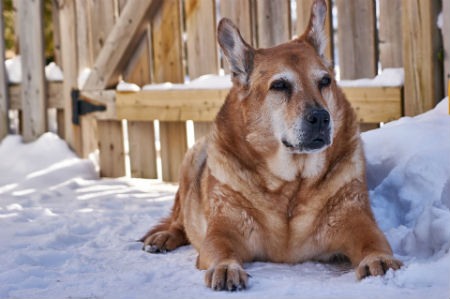Among the different diseases that can affect a dog during its life, osteoarthritis is one of the most common and delicate. This degenerative disease progressively affects the mobility of our canine. Sometimes,
osteoarthritis in dogs usually appears with small signs that can go unnoticed, due to lack of knowledge of it. But what is osteoarthritis? What are its symptoms? How to calm the effects of osteoarthritis in dogs? The answers to these questions are essential if you have a dog or are thinking of having one, since
identifying the signs of the disease can help alleviate its effects that it will cause in your dog. And thus ensure better well-being amid all the consequences of osteoarthritis.
What is osteoarthritis?
It is a
degenerative disease that affects the joints and bones . This condition occurs in both humans and animals, with dogs being commonly affected by its damage, limitations and intense pain.
In the case of osteoarthritis in dogs, this occurs through the deterioration of the cartilage of our canines, which are located in the bones, which prevent the bones from colliding with each other, which is why they are known as
protectors . That is why the disease occurs in areas such as the hip, knee, elbow, wrist and spine, causing intense pain as its process progresses. When the cartilage wears out, it causes the bones to be left unprotected, therefore, they rub against each other, which causes great discomfort. This process is what is known as osteoarthritis in dogs. Osteoarthritis in dogs has no distinction between breed or age; it can appear in small or large breed dogs. Although it is a progressive disease, meaning it develops over time, adult dogs are more likely to suffer from it.
Osteoarthritis in dogs: symptoms
As mentioned,
osteoarthritis in dogs is a degenerative disease , so its symptoms can occur when it is in a fairly advanced state. However, in many cases, the symptoms of osteoarthritis in dogs can be detected early. Although it is an incurable disease, recognizing the signs and offering the greatest well-being to our puppy on this occasion is the best alternative.
Limited mobility
If your dog has trouble getting up, limps, or spends a lot of time lying down, it may be a sign of the onset of osteoarthritis. Difficulty moving, getting up, and a decrease in walking or exercising compared to previous occasions, is another of the frequent aspects when this disease occurs.
Changes in behavior
Another common symptom is aggressiveness due to pain, at times when they are more intense. If your dog shows behavioral changes, it is possible that he is suffering from osteoarthritis, so a visit to the veterinarian is the best option to know how to manage these cases.
Sensitivity to physical contact
If you notice that, when you try to touch it,
your dog becomes aggressive or tries to avoid contact , it may be due to the pain that osteoarthritis causes in its body. The intensity of the pain can be very high, so the dog will not want to be touched for fear of getting hurt.
Lack of appetite
As the pain of osteoarthritis in the dog increases, it may experience loss of appetite, as the discomfort becomes increasingly stronger. Also accompanied by discouragement or depression, due to the limitations caused by the disease.
Tips to alleviate the effects of osteoarthritis in dogs
As we have mentioned throughout the article, osteoarthritis is a disease that has no cure. However, within its progress there are
different ways to relieve the pain and discomfort it causes in canines. In this way, the condition can be made more bearable for our sick pet. Here we will mention some of them:
Control weight
The joints and bones of the canine are what support all its weight. An excess of it can cause accelerated wear of the bones, facilitating the appearance of osteoarthritis. Therefore, controlling the dog's weight and diet is a way to ensure that the disease does not worsen quickly.
Workout routines
Obviously, as the disease progresses, the dog will be able, to a lesser extent, to do intense exercises. However, there are specialized routines for dogs with this condition that, properly applied, generate well-being and
help slow down the progression of the disease .
Therapeutic massages
There are also massages indicated to relieve tension in areas affected by osteoarthritis in dogs. It is important to go to a veterinarian and have him indicate the massages, exercises and diet that our dog must follow to improve its conditions during the progress of the disease.
Rest
Rest is also important. Accompanied by blankets when it's cold and a comfortable bed, you will make it easier for the dog to feel calm. It is a suitable position where you are not so affected by the normal discomfort of the disease.
Periodic checks
Periodic visits to the veterinarian, both when detecting an anomaly to identify the disease, and performing x-rays and other studies to determine its progress. As well as compliance with the treatment and indications, which is very necessary when in the presence of dogs with osteoarthritis. These essential aspects cannot guarantee the cure of osteoarthritis in dogs. However, they will stop its accelerated progress, reduce inflammation and pain, and also contribute to more comfortable mobility of the joints. Thinking about the well-being and quality of life of the dog with this condition, it is necessary to take these tips into account and be alert to the symptoms that the canine may present. In this way, a prompt visit to the veterinarian and adequate treatment
will guarantee that osteoarthritis does not become a punishment for our dog .
Other articles that may be of interest to you:















